Assessing Park Accessibility Based on a Dynamic Huff Two-Step Floating Catchment Area Method and Map Service API
Abstract
:1. Introduction
2. Materials and Methods
2.1. Study Area
2.2. Data Sources
2.2.1. Park Data
2.2.2. Population Data
2.2.3. Travel Time Data
2.3. Methodology
2.3.1. Accessibility Model: An H2SFCA Model
2.3.2. Dynamic Travel Modes
2.3.3. Locally Available Park Green Space
2.3.4. Gini Coefficient and Bivariate Local Moran’s I index
3. Results
3.1. Analysis of Travel Time for Different Modes
3.2. Accessibility Analysis for Different Modes
3.2.1. Numerical Statistical Analysis of Accessibility
3.2.2. Spatial Distribution Analysis of Accessibility
3.3. Accessibility Equity Analysis for Different Modes
3.3.1. Gini Coefficient Statistical Analysis
3.3.2. Correlation Analysis of Accessibility Distribution and Population Density
4. Discussion
4.1. Advantage
4.2. Interpretation and Application
4.3. Limitation
5. Conclusions
Author Contributions
Funding
Institutional Review Board Statement
Informed Consent Statement
Data Availability Statement
Conflicts of Interest
References
- Park, J.; Kim, J.H.; Dong, K.L.; Park, C.Y.; Jeong, S.G. The Influence of Small Green Space Type and Structure at the Street Level on Urban Heat Island Mitigation. Urban For. Urban Green. 2017, 21, 203–212. [Google Scholar] [CrossRef]
- Gaikwad, A.; Shinde, K. Use of Parks by Older Persons and Perceived Health Benefits: A Developing Country Context. Cities 2019, 84, 134–142. [Google Scholar] [CrossRef]
- Zheng, Z.; Zhang, L.; Qin, Y.; Wang, X.; Zhang, J.; Yan, Y.U. Accessibility of Parks and Scenic Spots in Kaifeng City Based on Multi-Mode Traffic Network. Area Res. Dev. 2019, 38, 60–67. [Google Scholar]
- Keesstra, S.; Nunes, J.; Novara, A.; Finger, D.; Avelar, D.; Kalantari, Z.; Cerdà, A. The Superior Effect of Nature Based Solutions in Land Management for Enhancing Ecosystem Services. Sci. Total Environ. 2018, 610, 997–1009. [Google Scholar] [CrossRef] [PubMed] [Green Version]
- Liu, Y.; Wang, H.; Jiao, L.; Liu, Y.; He, J.; Ai, T. Road Centrality and Landscape Spatial Patterns in Wuhan Metropolitan Area, China. Chin. Geogr. Sci. 2015, 25, 511–522.22. [Google Scholar] [CrossRef] [Green Version]
- Zheng, Z.; Shen, W.; Li, Y.; Qin, Y.; Wang, L. Spatial Equity of Park Green Space Using KD2SFCA and Web Map API: A Case Study of Zhengzhou, China. Appl. Geogr. 2020, 123, 102310. [Google Scholar] [CrossRef]
- Xing, L.; Liu, Y.; Liu, X.; Wei, X.; Mao, Y. Spatio-Temporal Disparity between Demand and Supply of Park Green Space Service in Urban Area of Wuhan from 2000 to 2014. Habitat Int. 2018, 71, 49–59. [Google Scholar] [CrossRef]
- Wolch, J.R.; Byrne, J.; Newell, J.P. Urban Green Space, Public Health, and Environmental Justice: The Challenge of Making Cities ‘Just Green Enough’. Landsc. Urban Plan. 2014, 125, 234–244. [Google Scholar] [CrossRef] [Green Version]
- Gu, X.; Tao, S.; Dai, B. Spatial Accessibility of Country Parks in Shanghai, China. Urban For. Urban Green. 2017, 27, 373–382. [Google Scholar] [CrossRef]
- Wang, M.; Mu, L. Spatial Disparities of Uber Accessibility: An Exploratory Analysis in Atlanta, USA. Comput. Environ. Urban Syst. 2018, 67, 169–175. [Google Scholar] [CrossRef]
- Hansen; Walter, G. How Accessibility Shapes Land Use. J. Am. Inst. Plann. 1959, 25, 73–76. [Google Scholar] [CrossRef]
- Yang, X.; Zheng, W.; Li, Z.; Tang, Z. An Assessment of Urban Park Access in Shanghai—Implications for the Social Equity in Urban China. Landsc. Urban Plan. 2016, 157, 383–393. [Google Scholar]
- Liu, Y.; Wei, X.; Jiao, L.; Wang, H. Relationships between Street Centrality and Land Use Intensity in Wuhan, China. J. Urban Plan. Dev. 2016, 142, 05015001. [Google Scholar] [CrossRef]
- Mix, R.; Hurtubia, R.; Raveau, S. Optimal Location of Bike-Sharing Stations: A Built Environment and Accessibility Approach. Transp. Res. Part A Policy Pract. 2022, 160, 126–142. [Google Scholar] [CrossRef]
- Rigolon, A. A Complex Landscape of Inequity in Access to Urban Parks: A Literature Review. Landsc. Urban Plan. 2016, 153, 160–169. [Google Scholar] [CrossRef]
- Wang, J.; Deng, Y.; Song, C.; Tian, D. Measuring Time Accessibility and Its Spatial Characteristics in the Urban Areas of Beijing. J. Geogr. Sci. 2016, 26, 1754–1768. [Google Scholar] [CrossRef] [Green Version]
- Comber, A.; Brunsdon, C.; Green, E. Using a GIS-based network analysis to determine urban greenspace accessibility for different ethnic and religious groups. Landsc. Urban Plan. 2008, 86, 103–114. [Google Scholar] [CrossRef] [Green Version]
- Dony, C.C.; Delmelle, E.M.; Delmelle, E.C. Re-Conceptualizing Accessibility to Parks in Multi-Modal Cities: A Variable-Width Floating Catchment Area (VFCA) Method. Landsc. Urban Plan. 2015, 143, 90–99. [Google Scholar] [CrossRef]
- Dadashpoor, H.; Rostami, F.; Alizadeh, B. Is Inequality in the Distribution of Urban Facilities Inequitable? Exploring a Method for Identifying Spatial Inequity in an Iranian City. Cities 2016, 52, 159–172. [Google Scholar] [CrossRef]
- Weiss, C.C.; Purciel, M.; Bader, M.; Quinn, J.W.; Lovasi, G.; Neckerman, K.M.; Rundle, A.G. Reconsidering Access: Park Facilities and Neighborhood Disamenities in New York City. J. Urban Health 2011, 88, 297–310. [Google Scholar] [CrossRef] [Green Version]
- Ren, J.; Wang, Y. Spatial accessibility of park green space in Huangpu District of Shanghai based on modified two-step floating catchment area method. Prog. Geogr. 2021, 40, 774–783. [Google Scholar] [CrossRef]
- Boone, C.G.; Buckley, G.L.; Grove, J.M.; Sister, C. Parks and People: An Environmental Justice Inquiry in Baltimore, Maryland. Ann. Assoc. Am. Geogr. 2009, 99, 767–787. [Google Scholar] [CrossRef]
- Xu, M.; Xin, J.; Su, S.; Weng, M.; Cai, Z. Social Inequalities of Park Accessibility in Shenzhen, China: The Role of Park Quality, Transport Modes, and Hierarchical Socioeconomic Characteristics. J. Transp. Geogr. 2017, 62, 38–50. [Google Scholar] [CrossRef]
- Xing, L.; Liu, Y.; Liu, X. Measuring Spatial Disparity in Accessibility with a Multi-Mode Method Based on Park Green Spaces Classification in Wuhan, China. Appl. Geogr. 2018, 94, 251–261. [Google Scholar] [CrossRef]
- Tao, Z.; Cheng, Y. Research progress of the two-step floating catchment area method and extensions. Prog. Geogr. 2016, 35, 589–599. [Google Scholar]
- Qin, J.; Liu, Y.; Yi, D.; Sun, S.; Zhang, J. Spatial Accessibility Analysis of Parks with Multiple Entrances Based on Real-Time Travel: The Case Study in Beijing. Sustainability 2020, 12, 7618. [Google Scholar] [CrossRef]
- Mao, L.; Nekorchuk, D. Measuring Spatial Accessibility to Healthcare for Populations with Multiple Transportation Modes. Health Place 2013, 24, 115–122. [Google Scholar] [CrossRef]
- Wang, Y.; Liu, Y.; Xing, L.; Zhang, Z. An Improved Accessibility-Based Model to Evaluate Educational Equity: A Case Study in the City of Wuhan. ISPRS Int. J. Geo-Inf. 2021, 10, 458. [Google Scholar] [CrossRef]
- Hu, S.; Song, W.; Li, C.; Lu, J. A Multi-Mode Gaussian-Based Two-Step Floating Catchment Area Method for Measuring Accessibility of Urban Parks. Cities 2020, 105, 102815. [Google Scholar] [CrossRef]
- Li, L.; Du, Q.; Ren, F.; Ma, X. Assessing Spatial Accessibility to Hierarchical Urban Parks by Multi-Types of Travel Distance in Shenzhen, China. Int. J. Environ. Res. Public Healt. 2019, 16, 1038. [Google Scholar] [CrossRef] [PubMed] [Green Version]
- Li, Z.; Fan, Z.; Song, Y.; Chai, Y. Assessing Equity in Park Accessibility Using a Travel Behavior-Based G2SFCA Method in Nanjing, China. J. Transp. Geogr. 2021, 96, 103179. [Google Scholar] [CrossRef]
- Ann, S.; Jiang, M.; Yamamoto, T. Influence Area of Transit-Oriented Development for Individual Delhi Metro Stations Considering Multimodal Accessibility. Sustainability 2019, 11, 4295. [Google Scholar] [CrossRef] [Green Version]
- Xiao, W.; Wei, Y.D.; Wan, N. Modeling Job Accessibility Using Online Map Data: An Extended Two-Step Floating Catchment Area Method with Multiple Travel Modes. J. Transp. Geogr. 2021, 93, 103065. [Google Scholar] [CrossRef]
- Zhang, J.; Cheng, Y.; Zhao, B. Assessing the Inequities in Access to Peri-Urban Parks at the Regional Level: A Case Study in China’s Largest Urban Agglomeration. Urban For. Urban Green. 2021, 65, 127334. [Google Scholar] [CrossRef]
- Lin, Y.; Zhou, Y.; Lin, M.; Wu, S.; Li, B. Exploring the Disparities in Park Accessibility through Mobile Phone Data: Evidence from Fuzhou of China. J. Environ. Manag. 2021, 281, 111849. [Google Scholar] [CrossRef]
- Liu, B.; Tian, Y.; Guo, M.; Tran, D.; Alwah, A.A.Q.; Xu, D. Evaluating the Disparity between Supply and Demand of Park Green Space Using a Multi-Dimensional Spatial Equity Evaluation Framework. Cities 2022, 121, 103484. [Google Scholar] [CrossRef]
- Jiang, H.; Xiao, R.; Zhou, C. The Comsumption’s Social Differentiation and Supply’s Strategies of Guangzhou Central District’s Public Parks. Planners 2010, 26, 66–72. [Google Scholar]
- Ogilvie, D.; Panter, J.; Guell, C.; Jones, A.; Mackett, R.; Griffin, S. Health Impacts of the Cambridgeshire Guided Busway: A Natural Experimental Study. Public Health Res. 2016, 4, 1–155. [Google Scholar] [CrossRef] [Green Version]
- Kabisch, N.; Strohbach, M.; Haase, D.; Kronenberg, J. Urban Green Space Availability in European Cities. Ecol. Indic. 2016, 70, 586–596. [Google Scholar] [CrossRef]
- Csomós, G.; Farkas, Z.J.; Kolcsár, R.A.; Szilassi, P.; Kovács, Z. Measuring Socio-Economic Disparities in Green Space Availability in Post-Socialist Cities. Habitat Int. 2021, 117, 102434. [Google Scholar] [CrossRef]
- Kolcsár, R.A.; Csikós, N.; Szilassi, P. Testing the Limitations of Buffer Zones and Urban Atlas Population Data in Urban Green Space Provision Analyses through the Case Study of Szeged, Hungary. Urban For. Urban Green. 2021, 57, 126942. [Google Scholar] [CrossRef]
- Gini, C. Concentration and Dependency Ratios. Riv. Politica Econ. 1997, 87, 769–792. [Google Scholar]
- Guo, S.; Song, C.; Pei, T.; Liu, Y.; Ma, T.; Du, Y.; Chen, J.; Fan, Z.; Tang, X.; Peng, Y.; et al. Accessibility to Urban Parks for Elderly Residents: Perspectives from Mobile Phone Data. Landsc. Urban Plan. 2019, 191, 103642. [Google Scholar] [CrossRef]
- Liang, H.; Zhang, Q. Assessing the Public Transport Service to Urban Parks on the Basis of Spatial Accessibility for Citizens in the Compact Megacity of Shanghai, China. Urban Stud. 2018, 55, 1983–1999. [Google Scholar] [CrossRef]
- Giles-Corti, B.; Broomhall, M.H.; Knuiman, M.; Collins, C.; Douglas, K.; Ng, K.; Lange, A.; Donovan, R.J. Increasing Walking: How Important Is Distance to, Attractiveness, and Size of Public Open Space? Am. J. Prevent. Med. 2005, 28, 169–176. [Google Scholar] [CrossRef]
- Ekkel, E.D.; De Vries, S. Nearby Green Space and Human Health: Evaluating Accessibility Metrics. Landsc. Urban Plan. 2017, 157, 214–220. [Google Scholar] [CrossRef]
- Wang, L.; Cao, X.; Li, T.; Gao, X. Accessibility Comparison and Spatial Differentiation of Xi’an Scenic Spots with Different Modes Based on Baidu Real-Time Travel. Chin. Geogr. Sci. 2019, 29, 848–860. [Google Scholar] [CrossRef] [Green Version]
- Vu, T.; Preston, J. Assessing the Social Costs of Urban Transport Infrastructure Options in Low and Middle Income Countries. Transp. Plan. Technol. 2020, 43, 365–384. [Google Scholar] [CrossRef]
- Gupta, K.; Roy, A.; Luthra, K.; Maithani, S. GIS Based Analysis for Assessing the Accessibility at Hierarchical Levels of Urban Green Spaces. Urban For. Urban Green. 2016, 18, 198–211. [Google Scholar] [CrossRef]
- Xing, L.; Liu, Y.; Wang, B.; Wang, Y.; Liu, H. An Environmental Justice Study on Spatial Access to Parks for Youth by Using an Improved 2SFCA Method in Wuhan, China. Cities 2020, 96, 102405. [Google Scholar] [CrossRef]
- Li, X.; Huang, Y.; Ma, X. Evaluation of the Accessible Urban Public Green Space at the Community-Scale with the Consideration of Temporal Accessibility and Quality. Ecol. Indic. 2021, 131, 108231. [Google Scholar] [CrossRef]
- Li, Z.; Chen, H.; Yan, W. Exploring Spatial Distribution of Urban Park Service Areas in Shanghai Based on Travel Time Estimation: A Method Combining Multi-Source Data. ISPRS Int. J. Geo-Inf. 2021, 10, 608. [Google Scholar] [CrossRef]
- Park, J.; Goldberg, D.W. A Review of Recent Spatial Accessibility Studies That Benefitted from Advanced Geospatial Information: Multimodal Transportation and Spatiotemporal Disaggregation. ISPRS Int. J. Geo-Inf. 2021, 10, 532. [Google Scholar] [CrossRef]
- Zhang, R.; Sun, F.; Shen, Y.; Peng, S.; Che, Y. Accessibility of Urban Park Benefits with Different Spatial Coverage: Spatial and Social Inequity. Appl. Geogr. 2021, 135, 102555. [Google Scholar] [CrossRef]
- Keesstra, S.; Mol, G.; De Leeuw, J.; Okx, J.; Molenaar, C.; De Cleen, M.; Visser, S. Soil-Related Sustainable Development Goals: Four Concepts to Make Land Degradation Neutrality and Restoration Work. Land 2018, 7, 133. [Google Scholar] [CrossRef] [Green Version]
- Keesstra, S.; Sannigrahi, S.; López-Vicente, M.; Pulido, M.; Novara, A.; Visser, S.; Kalantari, Z. The Role of Soils in Regulation and Provision of Blue and Green Water. Philos. Trans. R. Soc. B 2021, 376, 20200175. [Google Scholar] [CrossRef]
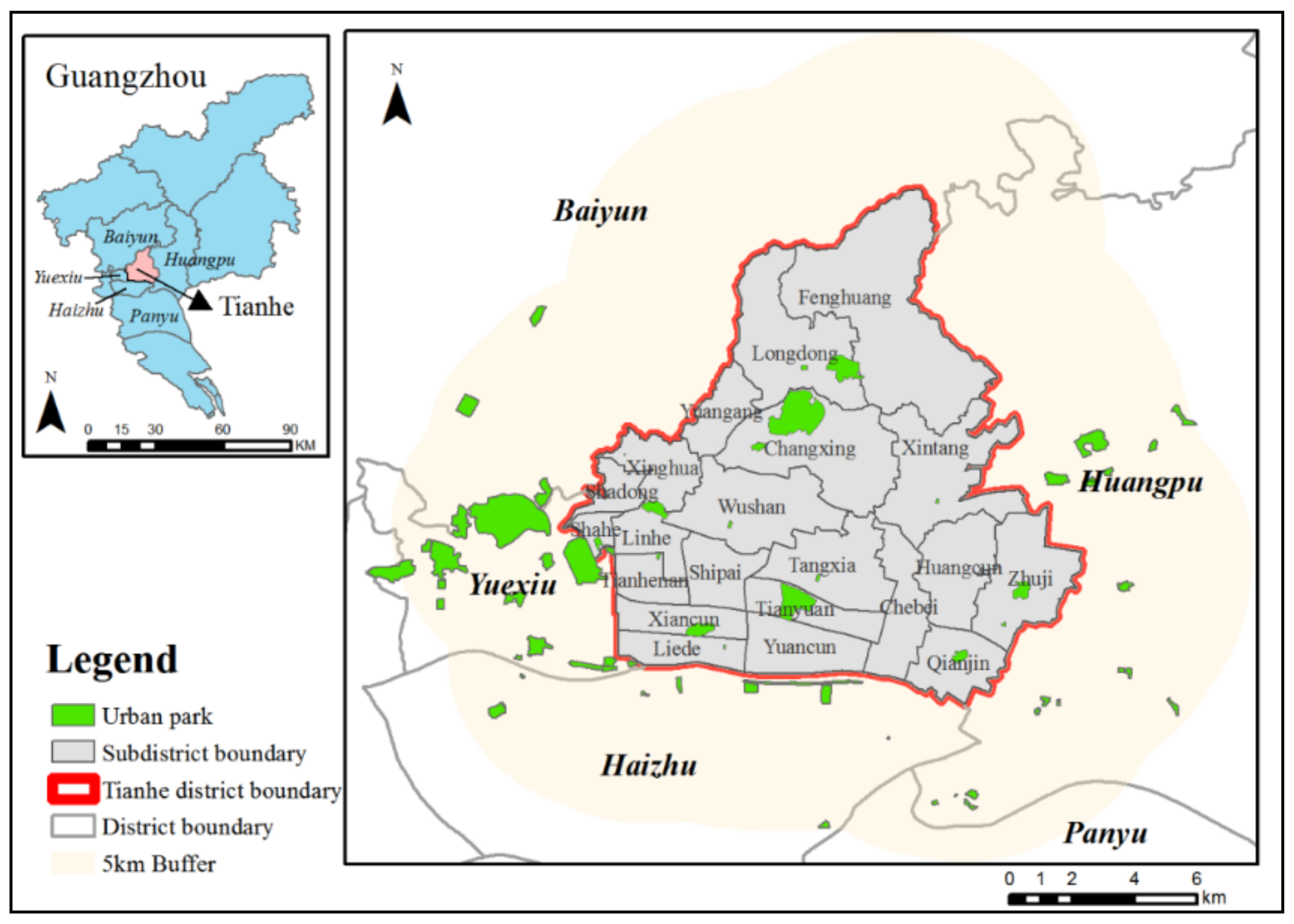
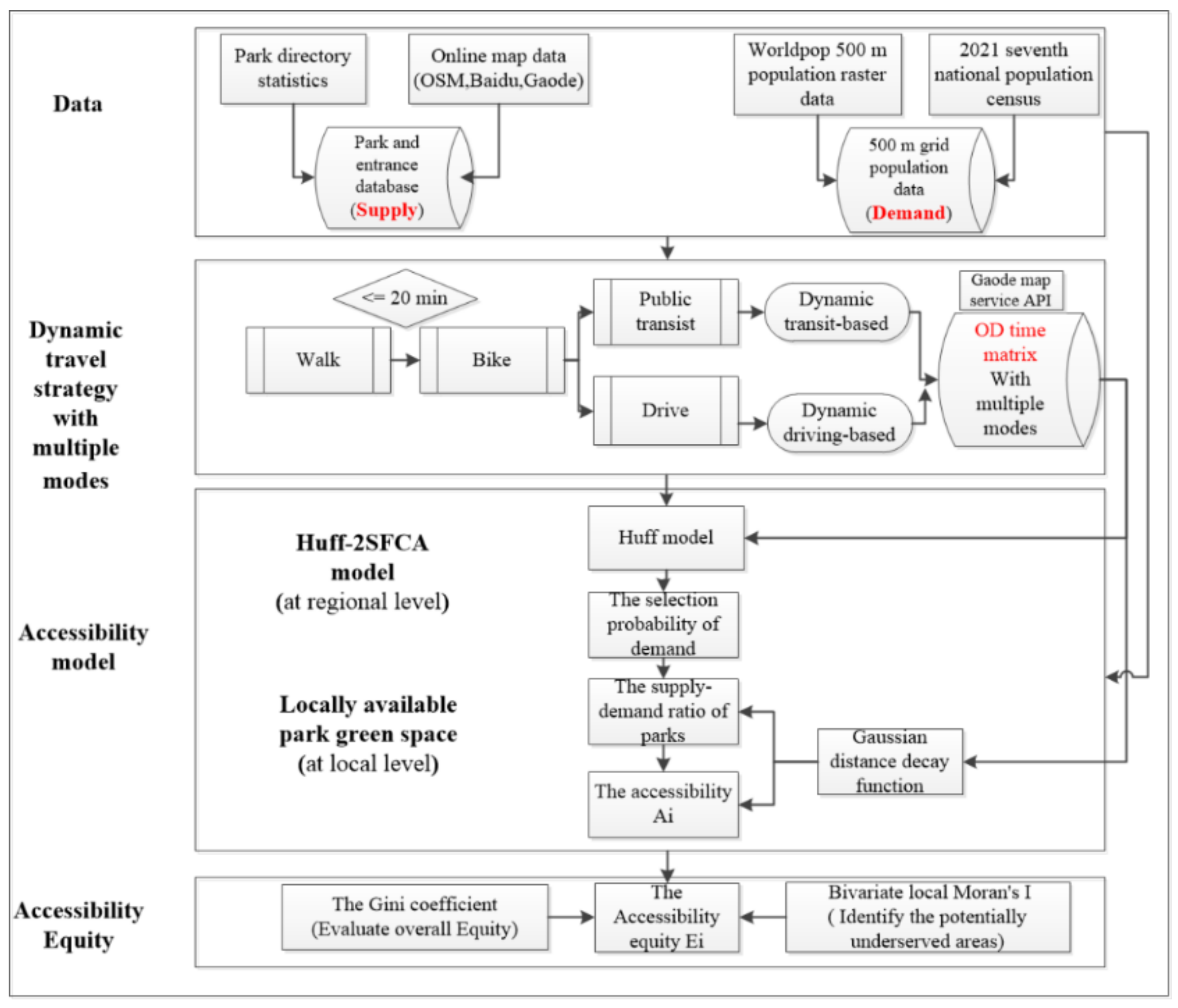
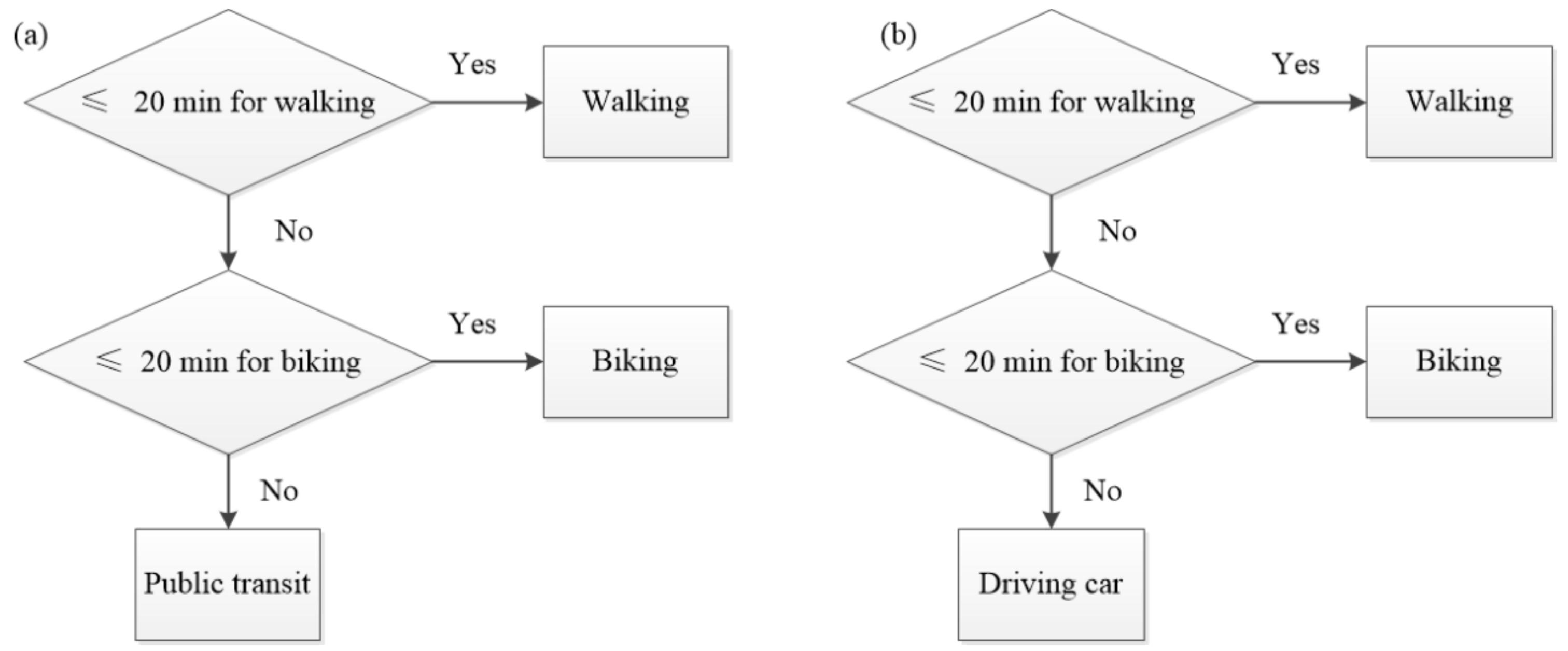
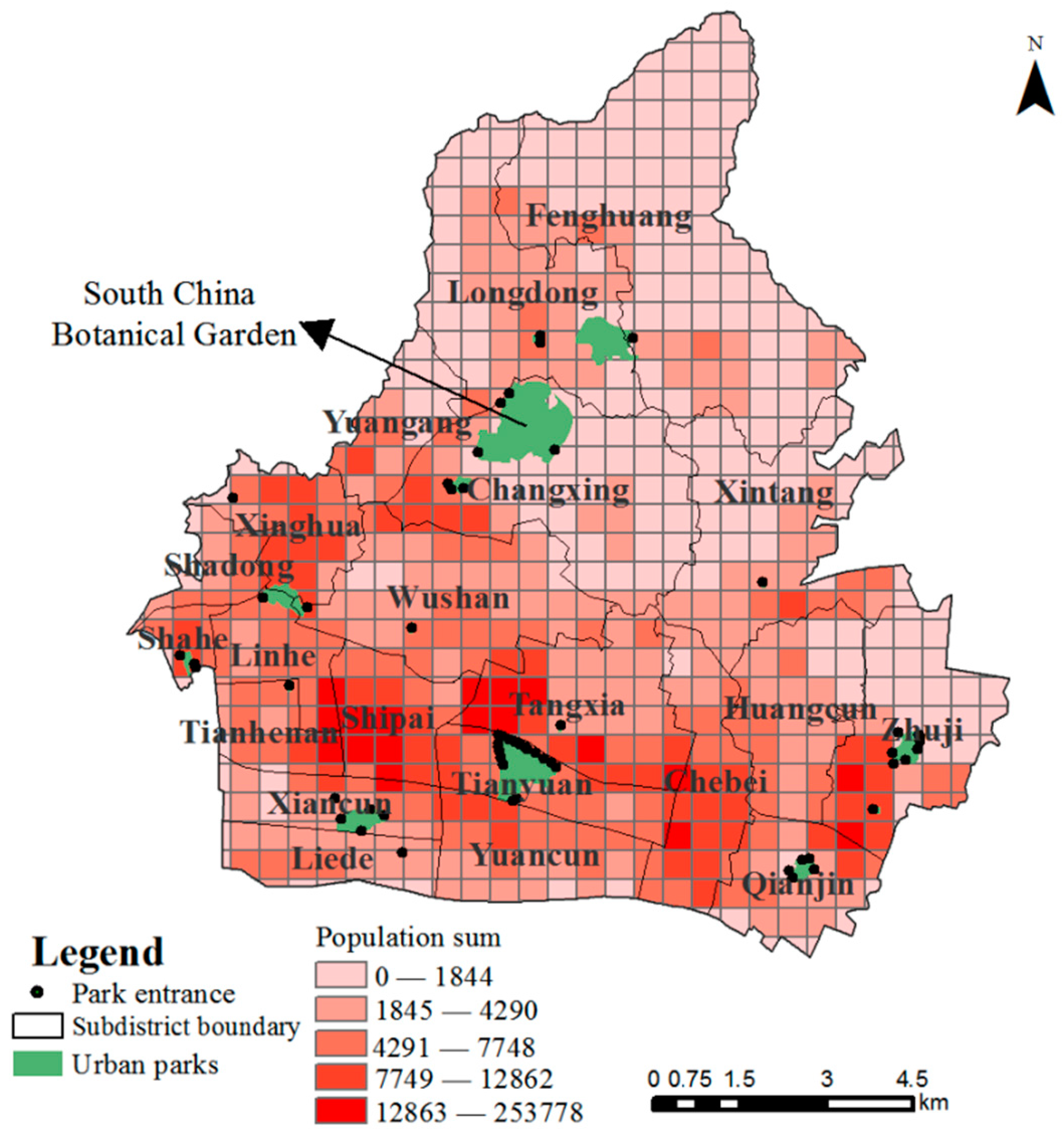
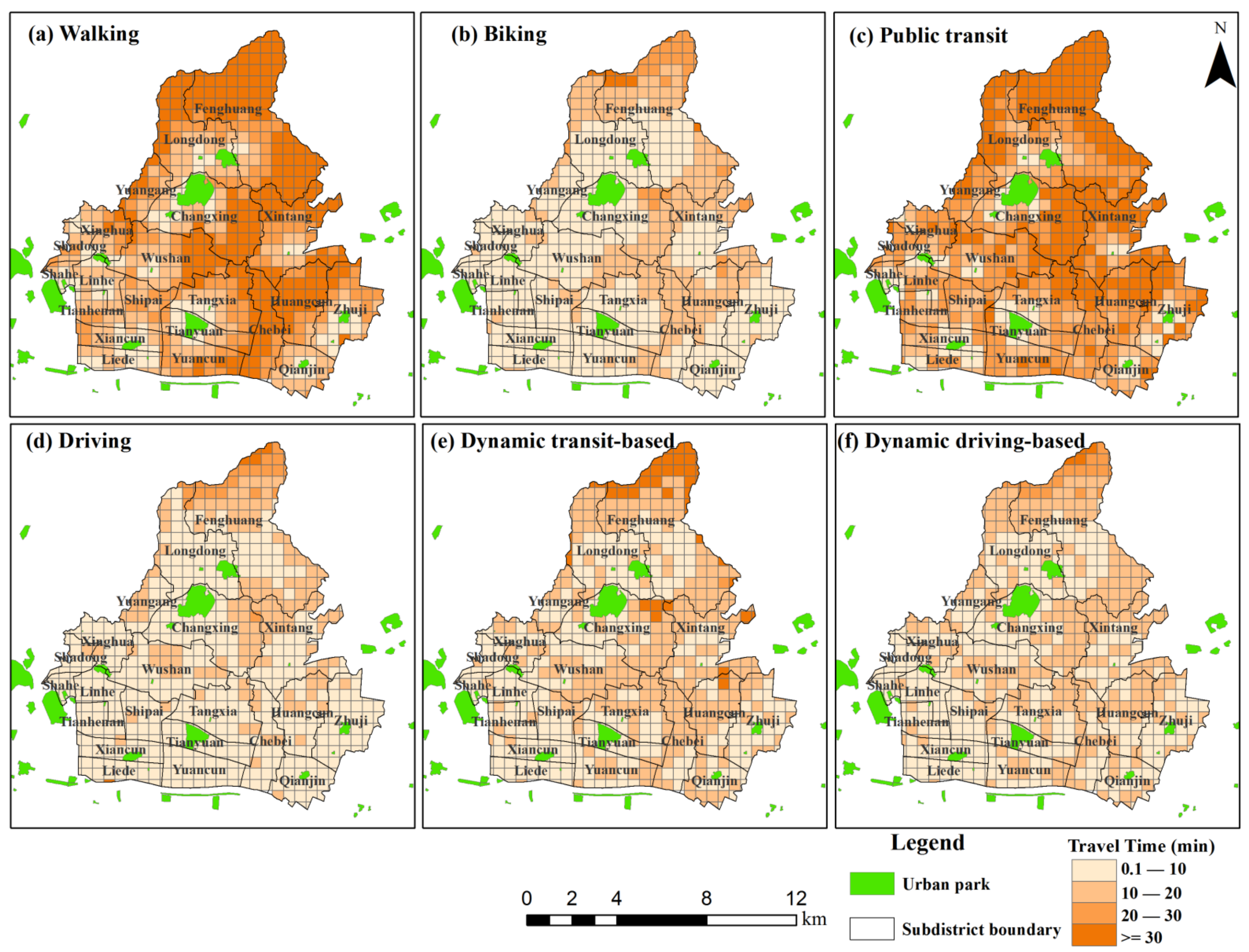

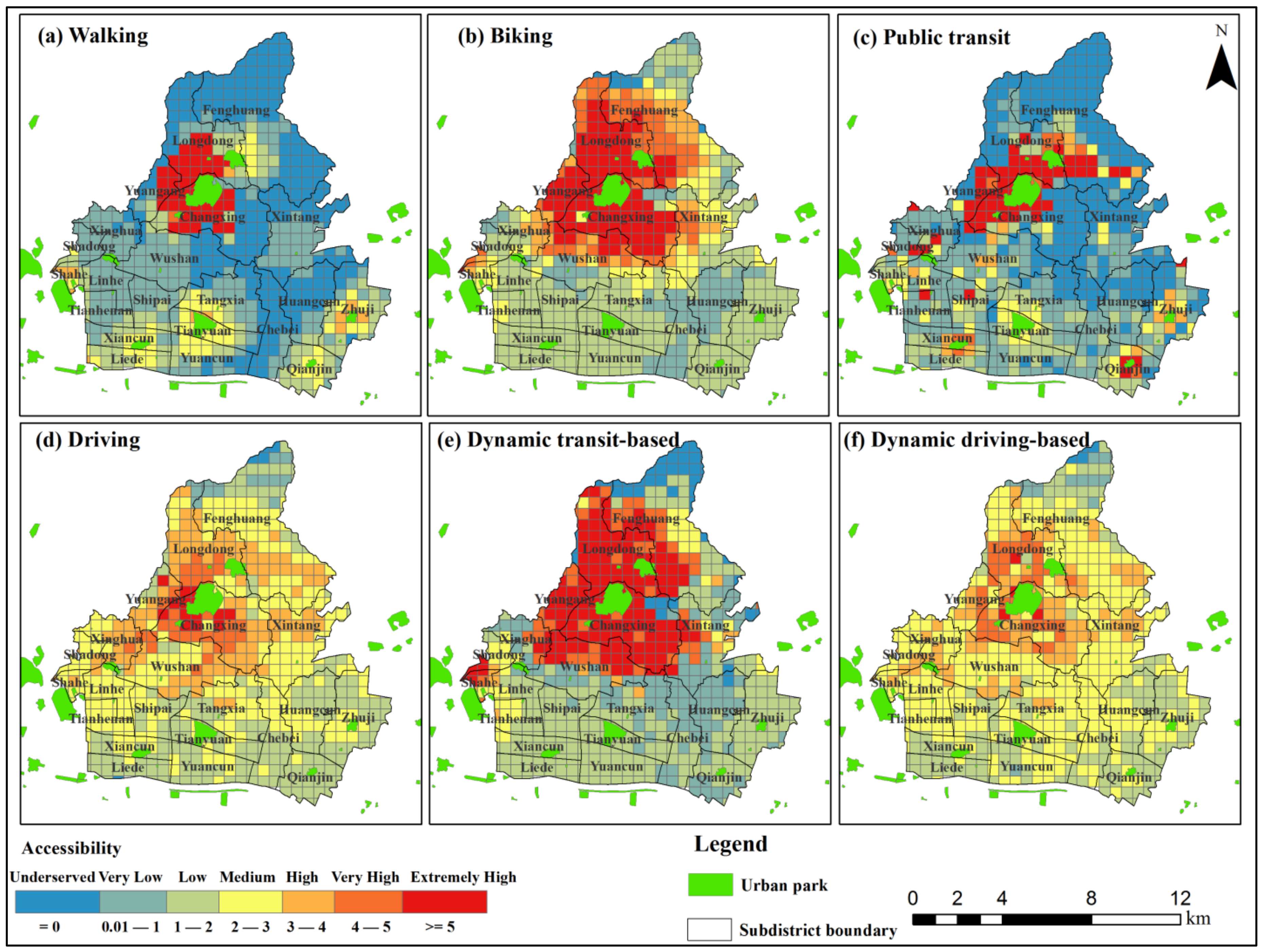
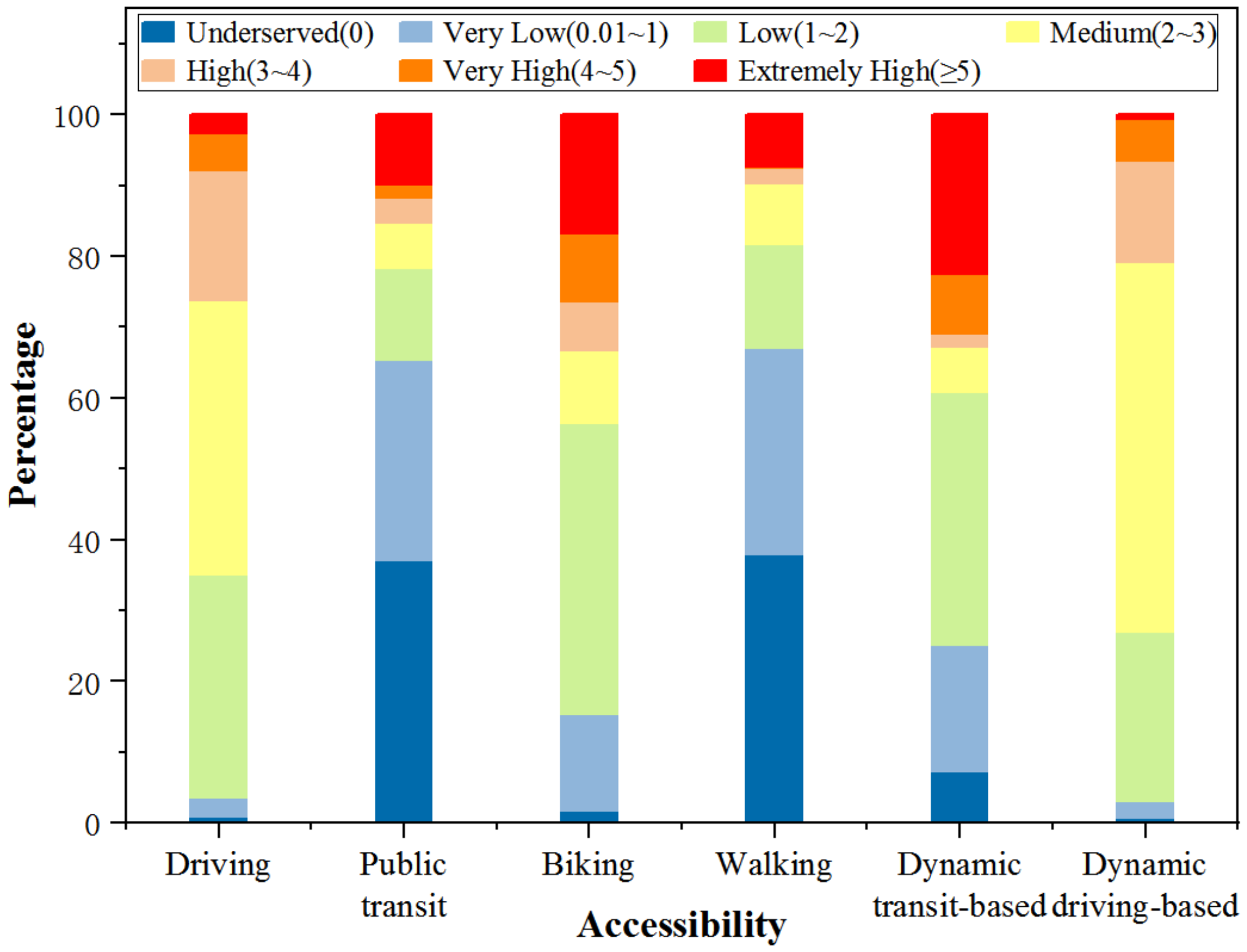
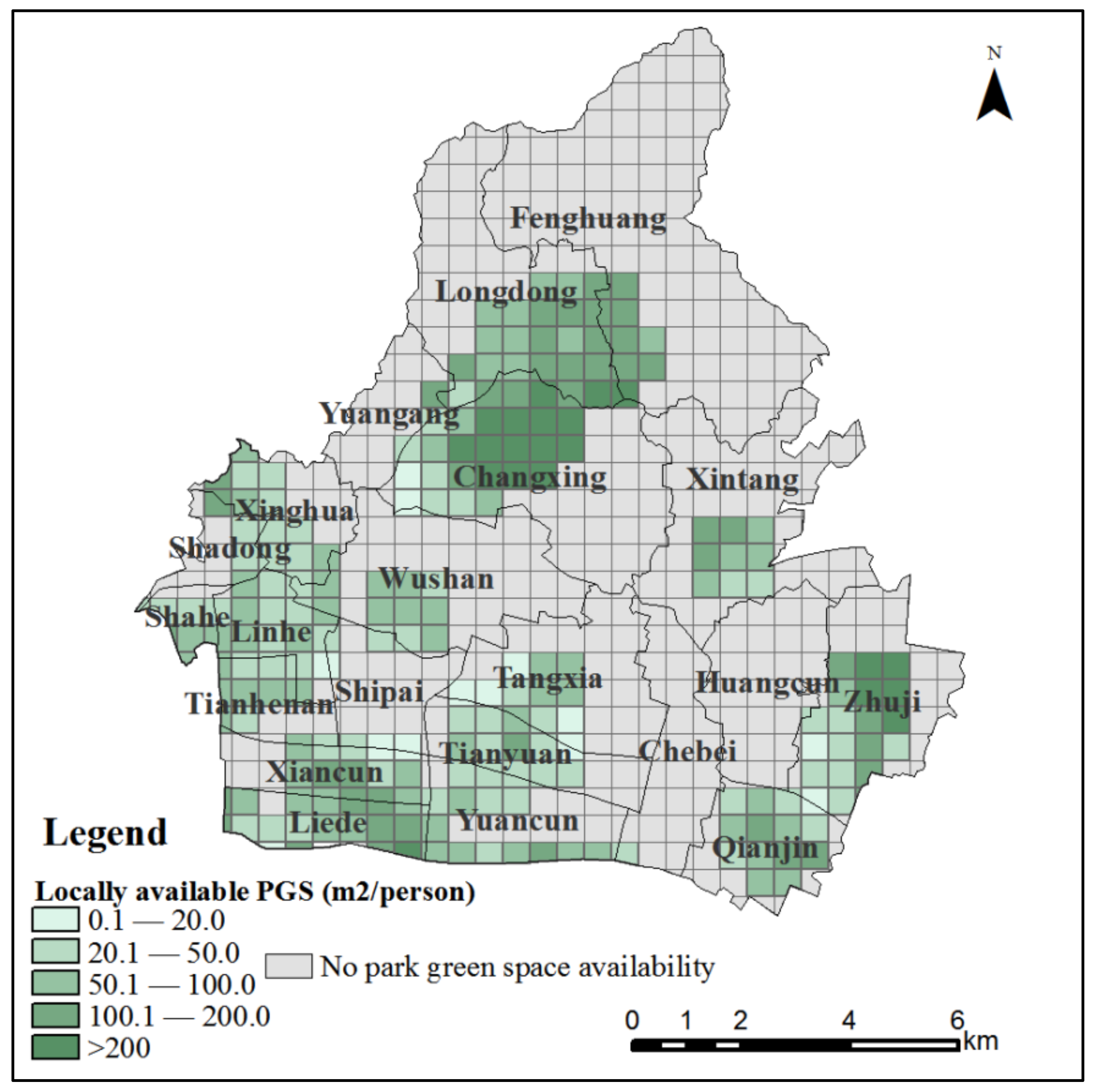
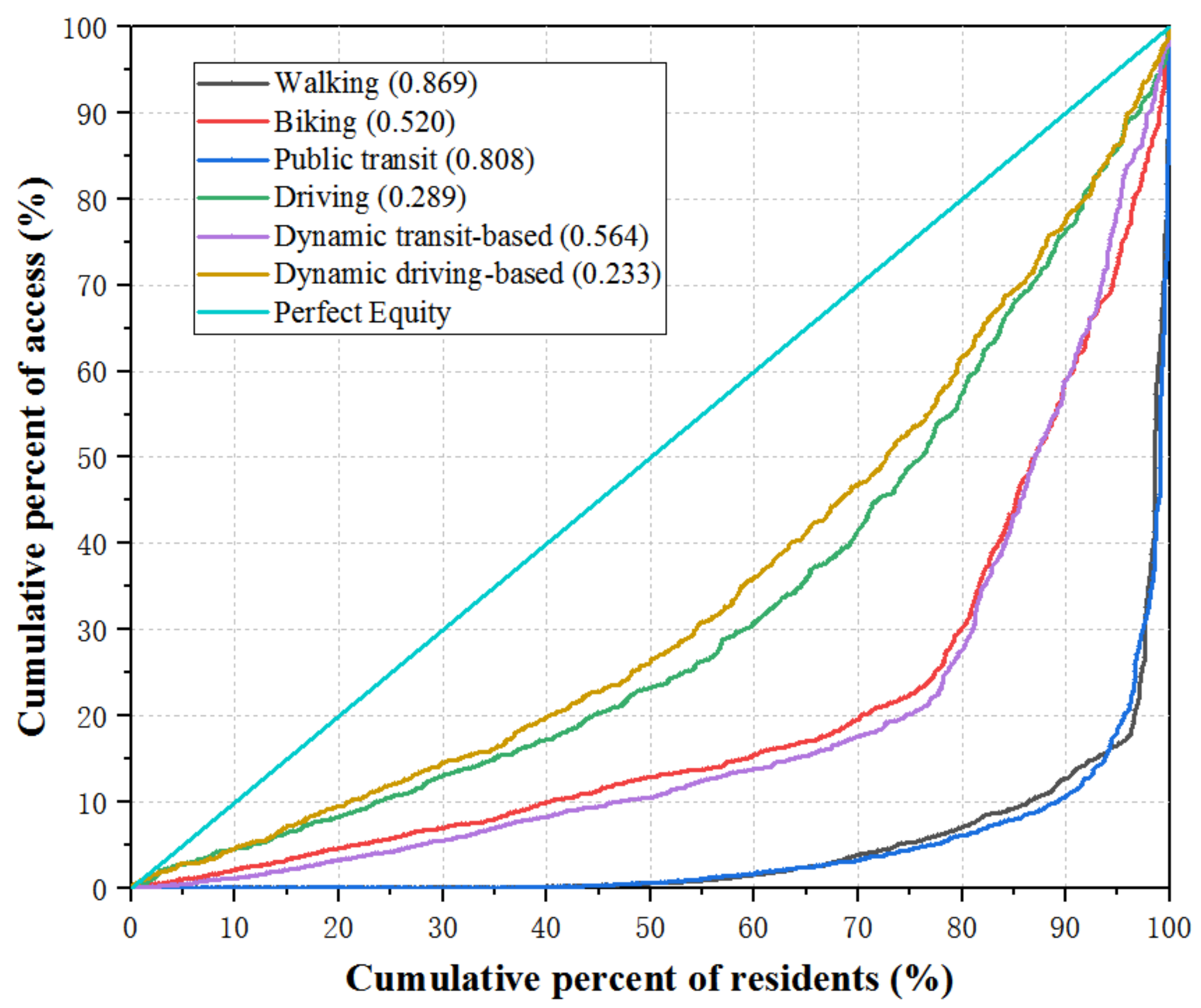
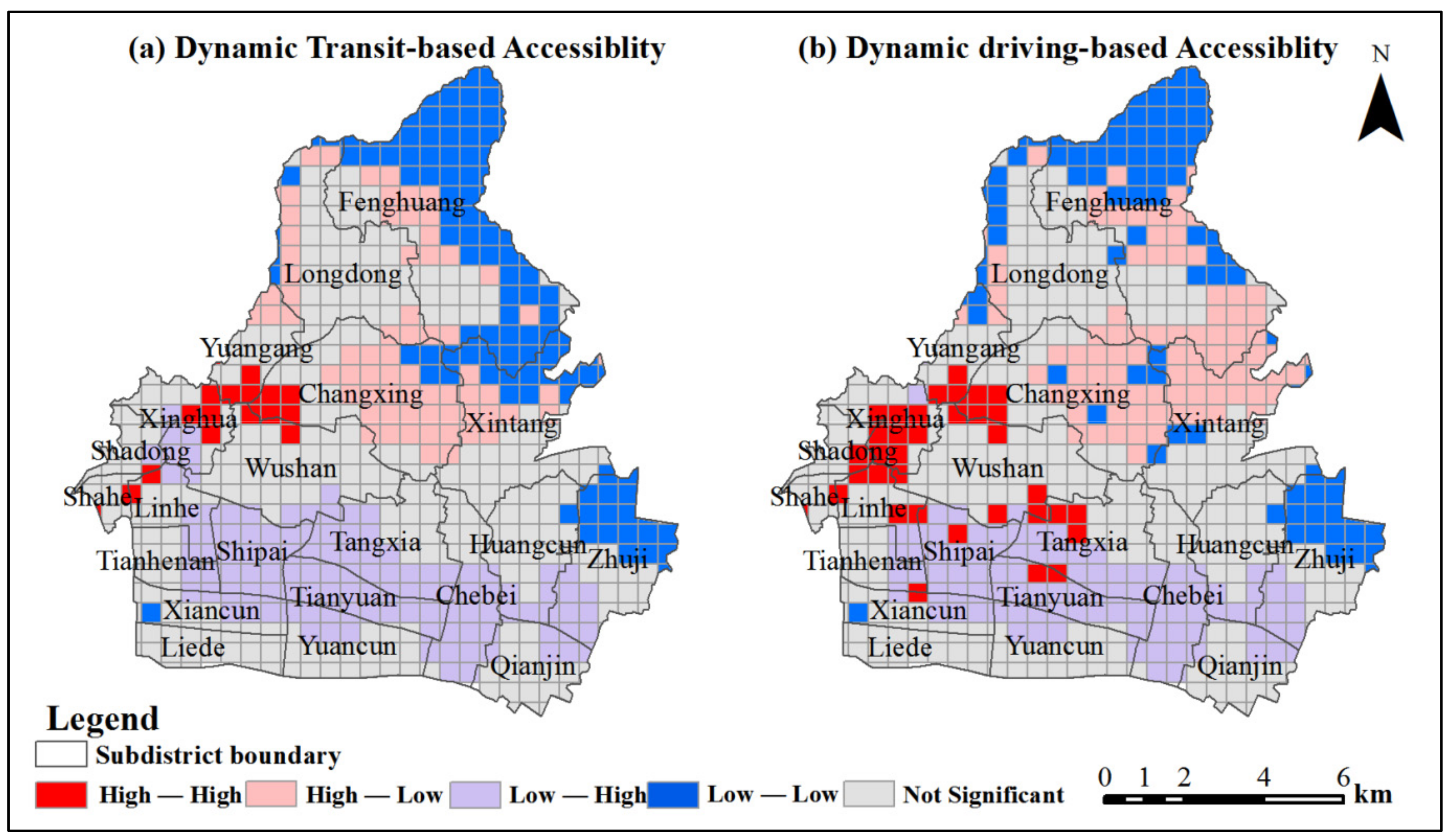
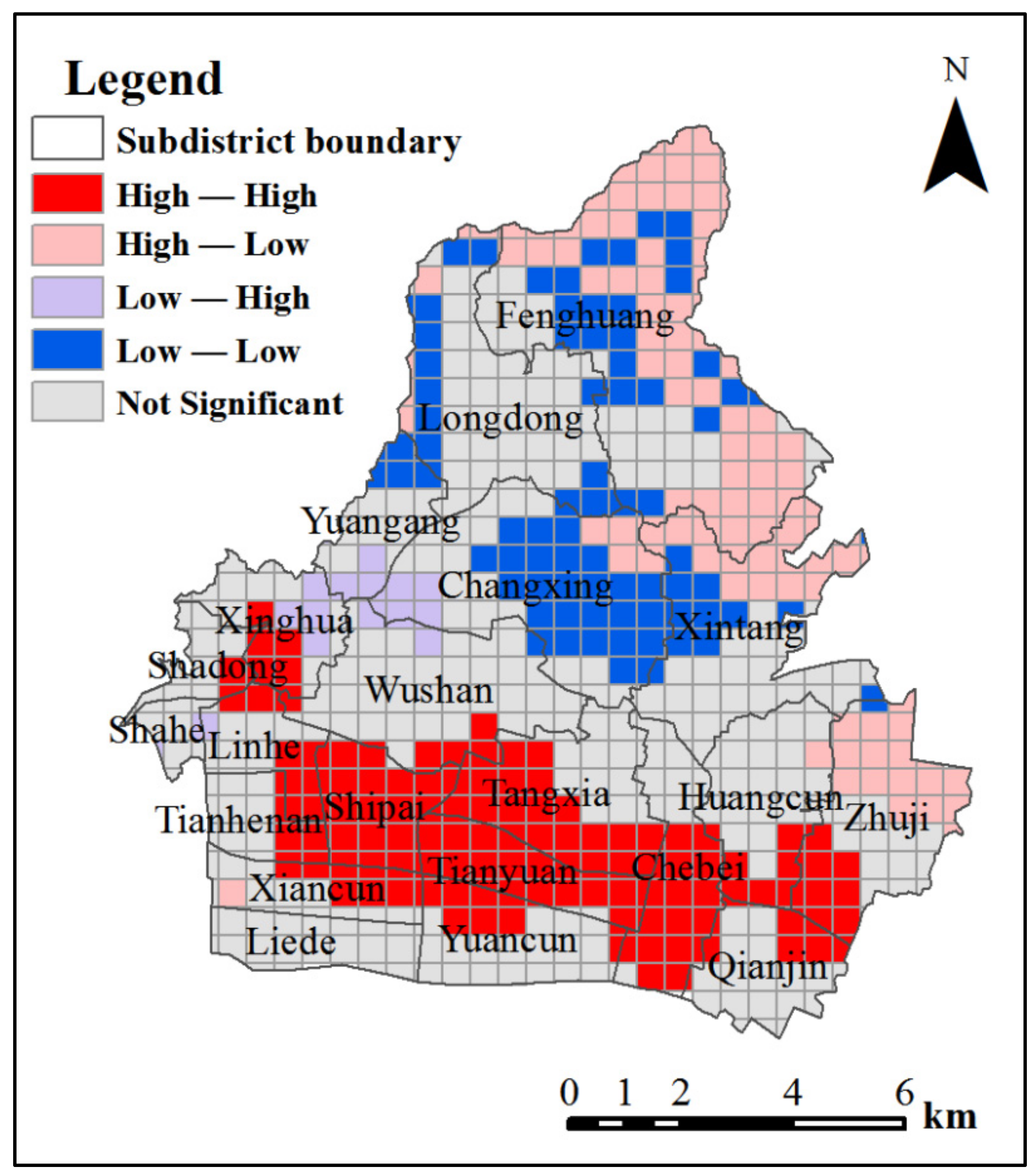
| Travel Mode | Max | Min | Mean | SD | N10 min | N20 min | N30 min |
|---|---|---|---|---|---|---|---|
| Walking | 148.75 | 0.43 | 28.94 | 21.55 | 88 (14.38%) | 246 (40.20%) | 381 (62.25%) |
| Biking | 44.75 | 0.02 | 9.52 | 6.69 | 379 (61.93%) | 566 (92.48%) | 602 (98.37%) |
| Public transit | 122.50 | 0.43 | 28.61 | 18.57 | 72 (11.76%) | 179 (29.25%) | 385 (62.91%) |
| Driving | 41.37 | 0.12 | 9.06 | 5.32 | 441 (72.06%) | 582 (95.10%) | 607 (99.18%) |
| Dynamic transit-based | 122.50 | 0.43 | 14.95 | 18.69 | 299 (48.86%) | 566 (92.48%) | 567 (92.65%) |
| Dynamic driving-based | 34.18 | 0.43 | 10.33 | 4.41 | 329 (53.76%) | 586 (95.75%) | 608 (99.35%) |
| Travel Mode | Max | Min | Mean | SD | Underserved Grid Number |
|---|---|---|---|---|---|
| Walking | 67.45 | 0.00 | 2.93 | 10.20 | 293 |
| Biking | 9.84 | 0.00 | 2.64 | 2.55 | 24 |
| Driving | 7.58 | 0.00 | 2.49 | 1.43 | 11 |
| Dynamic driving-based | 7.56 | 0.00 | 2.46 | 1.24 | 8 |
| Travel Mode | Max | Min | Mean | D | Underserved Grid Number |
|---|---|---|---|---|---|
| Walking | 67.45 | 0.00 | 2.93 | 10.20 | 293 |
| Biking | 9.84 | 0.00 | 2.64 | 2.55 | 24 |
| Public transit | 79.40 | 0.00 | 2.82 | 10.63 | 319 |
| Dynamic transit-based | 10.52 | 0.00 | 2.65 | 2.62 | 46 |
| Travel Mode | Walking | Biking | Public Transit | Driving |
|---|---|---|---|---|
| Dynamic transit-based | 0.465 ** | 0.941 ** | 0.455 ** | / |
| Dynamic driving-based | 0.573 ** | 0.712 ** | / | 0.746 ** |
| Bivariate Index | Moran’ I | Z-Value | p-Value |
|---|---|---|---|
| Dynamic driving-based mode and population | −0.036 * | −2.2613 | 0.014 |
| Dynamic transit-based mode and population | −0.136 ** | −8.7418 | 0.001 |
| The gap between two dynamic modes and population | 0.157 ** | 10.1822 | 0.001 |
Publisher’s Note: MDPI stays neutral with regard to jurisdictional claims in published maps and institutional affiliations. |
© 2022 by the authors. Licensee MDPI, Basel, Switzerland. This article is an open access article distributed under the terms and conditions of the Creative Commons Attribution (CC BY) license (https://creativecommons.org/licenses/by/4.0/).
Share and Cite
Wang, H.; Wei, X.; Ao, W. Assessing Park Accessibility Based on a Dynamic Huff Two-Step Floating Catchment Area Method and Map Service API. ISPRS Int. J. Geo-Inf. 2022, 11, 394. https://doi.org/10.3390/ijgi11070394
Wang H, Wei X, Ao W. Assessing Park Accessibility Based on a Dynamic Huff Two-Step Floating Catchment Area Method and Map Service API. ISPRS International Journal of Geo-Information. 2022; 11(7):394. https://doi.org/10.3390/ijgi11070394
Chicago/Turabian StyleWang, Huimin, Xiaojian Wei, and Weixuan Ao. 2022. "Assessing Park Accessibility Based on a Dynamic Huff Two-Step Floating Catchment Area Method and Map Service API" ISPRS International Journal of Geo-Information 11, no. 7: 394. https://doi.org/10.3390/ijgi11070394
APA StyleWang, H., Wei, X., & Ao, W. (2022). Assessing Park Accessibility Based on a Dynamic Huff Two-Step Floating Catchment Area Method and Map Service API. ISPRS International Journal of Geo-Information, 11(7), 394. https://doi.org/10.3390/ijgi11070394





